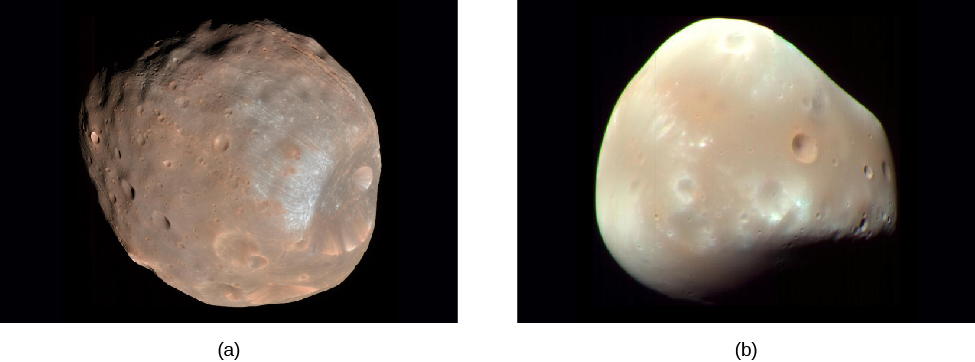| << Chapter < Page | Chapter >> Page > |
The greatest surprise of the Galileo flyby of Ida was the discovery of a moon (which was then named Dactyl ), in orbit about the asteroid ( [link] ). Although only 1.5 kilometers in diameter, smaller than many college campuses, Dactyl provides scientists with something otherwise beyond their reach—a measurement of the mass and density of Ida using Kepler’s laws. The moon’s distance of about 100 kilometers and its orbital period of about 24 hours indicate that Ida has a density of approximately 2.5 g/cm 3 , which matches the density of primitive rocks. Subsequently, both large visible-light telescopes and high-powered planetary radar have discovered many other asteroid moons, so that we are now able to accumulate valuable data on asteroid masses and densities.

By the way, Phobos and Deimos , the two small moons of Mars, are probably captured asteroids ( [link] ). They were first studied at close range by the Viking orbiters in 1977 and later by Mars Global Surveyor . Both are irregular, somewhat elongated, and heavily created, resembling other smaller asteroids. Their largest dimensions are about 26 kilometers and 16 kilometers, respectively. The small outer moons of Jupiter and Saturn were probably also captured from passing asteroids, perhaps early in the history of the solar system.

Beginning in the 1990s, spacecraft have provided close looks at several more asteroids. The Near Earth Asteroid Rendezvous (NEAR) spacecraft went into orbit around the S-type asteroid Eros, becoming a temporary moon of this asteroid. On its way to Eros, the NEAR spacecraft was renamed after planetary geologist Eugene Shoemaker, a pioneer in our understanding of craters and impacts.
For a year, the NEAR-Shoemaker spacecraft orbited the little asteroid at various altitudes, measuring its surface and interior composition as well as mapping Eros from all sides ( [link] ). The data showed that Eros is made of some of the most chemically primitive materials in the solar system. Several other asteroids have been revealed as made of loosely bound rubble throughout, but not Eros. Its uniform density (about the same as that of Earth’s crust) and extensive global-scale grooves and ridges show that it is a cracked but solid rock.

Notification Switch
Would you like to follow the 'Astronomy' conversation and receive update notifications?